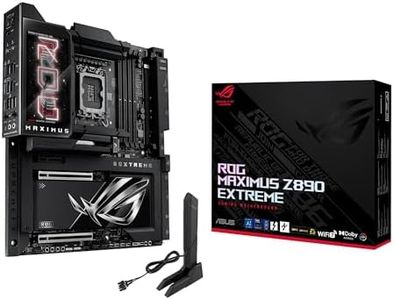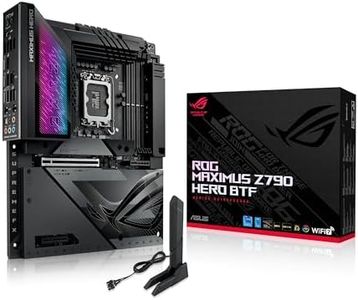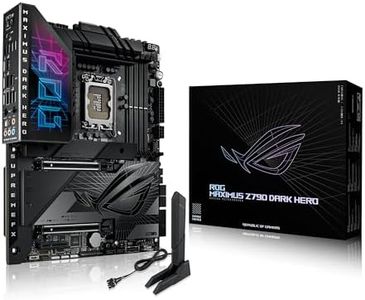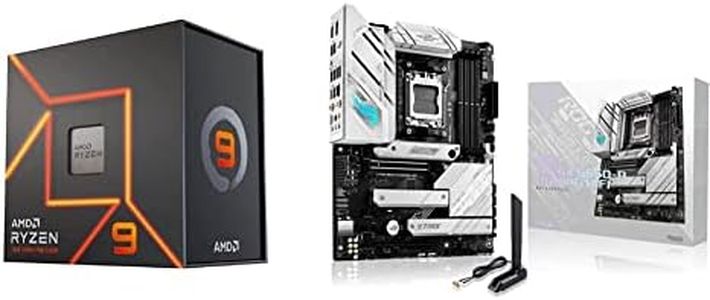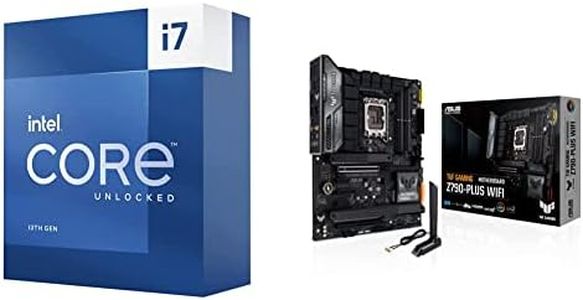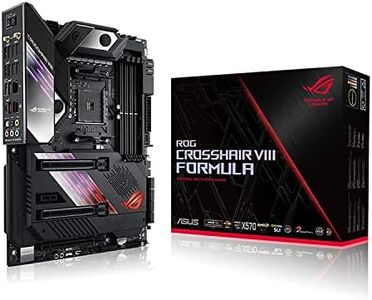10 Best ASUS Motherboards 2025 in the United States
Our technology thoroughly searches through the online shopping world, reviewing hundreds of sites. We then process and analyze this information, updating in real-time to bring you the latest top-rated products. This way, you always get the best and most current options available.

Our Top Picks
Winner
ASUS Pro WS W790E-SAGE SE Workstation Motherboard Socket Intel LGA 4677 (EEB Motherboard, PCIe 5.0, DDR5, USB 3.2 Gen 2)
Most important from
3 reviews
The ASUS Pro WS W790E-SAGE SE is designed with professionals in mind, particularly those needing a reliable workstation motherboard. It supports Intel Xeon processors, which is a strong selling point for users looking to build a powerful system for demanding tasks. With the ability to accommodate up to 2TB of DDR5 ECC memory, this motherboard is well-suited for applications that require heavy data processing or multitasking. The inclusion of multiple PCIe 5.0 slots ensures ample room for expansion, making it ideal for users who might want to add high-speed graphics cards or other peripherals in the future.
One of the standout features is the ultra-fast connectivity options, including dual 10G LAN ports and multiple M.2 slots for SSDs, which make it a great choice for data-intensive environments. The server-quality remote management capabilities via IPMI add another layer of convenience, making it easier to monitor and manage the system remotely.
The motherboard is larger than standard ATX boards, which might require a compatible case that can accommodate its EEB form factor. This could limit options for some users who prefer smaller setups. Additionally, while the robust power and heat management is a plus for performance, it may come at a higher price point compared to more basic motherboards. The product also targets a niche market of professionals rather than general consumers, which means that those not involved in heavy computing tasks may find it overkill. Its features might be too advanced for casual users or gamers who do not require such a high level of performance.
Most important from
3 reviews
ASUS ROG MAXIMUS Z890 EXTREME Intel® Z890 LGA 1851 E-ATX motherboard, Advanced AI PC-ready, 24+2+1+2 stages, DDR5, WiFi7, 2.5G/10G LAN, PCIe® 5.0 M.2, Thunderbolt™ 5, USB Type-C®, AI OC, 5” LCD Screen
Most important from
46 reviews
The ASUS ROG MAXIMUS Z890 EXTREME motherboard is a high-performance option designed for users looking to build advanced AI PCs. Its cutting-edge Intel LGA 1851 socket supports the latest Intel Core Ultra processors, making it well-suited for demanding applications. The motherboard features robust power solutions with 24+2+1+2 phases that ensure stability during intense workloads. With support for DDR5 RAM and a maximum capacity of 192 GB, it offers excellent performance for multitasking and heavy applications.
Connectivity is a strong point, as it includes dual Thunderbolt 5 ports and a variety of USB options, ensuring fast data transfer and compatibility with modern peripherals. The integrated Wi-Fi 7 and dual Ethernet connections provide excellent networking capabilities for gamers and professionals alike.
The advanced thermal management with massive heatsinks and dedicated cooling for M.2 slots helps maintain optimal performance during long sessions. The incorporation of exclusive ASUS AI technologies, such as AI Overclocking and AI Cooling, simplifies the setup process for users who may not be tech-savvy, making it a more accessible choice. The motherboard's premium features come at a price, making it a more expensive option in the market. Its size, being an E-ATX form factor, could pose compatibility issues for smaller cases. Tech enthusiasts and professionals looking to leverage AI capabilities and high-performance computing will find this motherboard particularly appealing.
Most important from
46 reviews
ROG MAXIMUS Z790 HERO BTF LGA 1700 ATX gaming motherboard,hidden-connector design, 20+1+2 power stages,DDR5,5xM.2 slots,PCIe 5.0 NVMe SSD slot onboard,Wi-Fi 7 with WiFi Q-Antenna,2xThunderbolt 4 ports
Most important from
698 reviews
The ASUS ROG MAXIMUS Z790 HERO BTF is an advanced gaming motherboard designed for serious PC enthusiasts. It features the Intel LGA 1700 socket, making it compatible with the latest Intel Core processors (14th, 13th, 12th Gen), Pentium Gold, and Celeron processors. One of its standout features is the hidden-connector design, which significantly improves cable management, making for a cleaner and more organized build.
Additionally, its robust power solution (20+1+2 power stages) and optimized VRM thermals ensure stable performance, even under high loads, making it suitable for gamers and power users alike. The motherboard supports DDR5 RAM, providing faster speeds and better performance over DDR4, and comes with five M.2 slots (one PCIe 5.0 and four PCIe 4.0) for extensive storage options with premium cooling solutions.
With Wi-Fi 7 and dual Thunderbolt 4 ports, connectivity is top-notch, catering to modern high-speed requirements. However, its premium features and specifications come at a higher price point, which might not be justifiable for casual users or those with simpler needs. Moreover, users should be prepared for a more involved setup process due to its advanced features. This motherboard excels in performance, connectivity, and future-proofing, making it a great choice for high-end gaming and demanding applications, but may be overkill for less intensive use cases.
Most important from
698 reviews
Buying Guide for the Best ASUS Motherboards
Choosing the right motherboard is crucial as it serves as the backbone of your computer, connecting all the components and allowing them to communicate with each other. When selecting an ASUS motherboard, you need to consider several key specifications to ensure compatibility with your other components and to meet your performance needs. Understanding these specs will help you make an informed decision and get the best fit for your system.FAQ
Most Popular Categories Right Now

